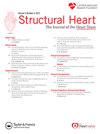Tricuspid Annulus Measurements in Severe Tricuspid Regurgitation: Comparative Analysis of Cardiac-Gated Computed Tomography Versus Three-Dimensional Transesophageal Echocardiography
IF 2.8
Q3 CARDIAC & CARDIOVASCULAR SYSTEMS
引用次数: 0
Abstract
Background
Treatment options for severe tricuspid regurgitation (TR) require a multimodal analysis of the tricuspid annulus (TA). Cardiac computed tomography (CT) is currently considered the gold standard for annular perimeter measurements, though three-dimensional transesophageal echocardiography (3D TEE) can yield similar results. As such, we sought to determine the accuracy and precision of 3D TEE imaging of the TA perimeter compared to CT imaging in outpatients with severe TR.
Methods
Fifty-five patients were referred for multimodality workup for severe TR that included CT and 3D TEE. The 3D TEE imaging was performed in the mid-esophageal (ME) and transgastric views. A semiautomated software program was used to identify and measure the TA with additional manual optimization by the reader. These 3D TEE measurements were compared to cardiac CT imaging.
Results
Out of 55 patients, 3 were excluded for hiatal hernias and 1 was excluded for severe kidney disease. Fifty-one studied patients had an average age of 76 ± 10 years with 59% female. The 3D TEE analysis of the TA perimeter demonstrated an excellent correlation with CT from the ME view, R = 0.88, and from the TG view, R = 0.86, with an average difference of approximately 8.5% when compared to CT. TEE inter-reader variability was approximately 6%, whereas CT variability was 1.4%
Conclusions
The 3D TEE TA perimeter measurements are accurate when compared to CT with a variability of 8.5%. While CT remains more precise, 3D TEE imaging for TA sizing should be considered a near-equivalent modality to CT.
重度三尖瓣反流的三尖瓣环测量:心脏门控计算机断层扫描与三维经食管超声心动图的比较分析
背景:严重三尖瓣反流(TR)的治疗方案需要对三尖瓣环(TA)进行多模态分析。心脏计算机断层扫描(CT)目前被认为是环形周长测量的金标准,尽管三维经食管超声心动图(3D TEE)可以产生类似的结果。因此,我们试图确定与CT成像相比,门诊严重TR患者TA周缘3D TEE成像的准确性和精度。方法55例患者接受包括CT和3D TEE在内的严重TR多模式检查。在食管中位(ME)和经胃位进行三维TEE成像。使用半自动软件程序识别和测量TA,并由读者进行额外的手动优化。将这些3D TEE测量结果与心脏CT图像进行比较。结果55例患者中3例因裂孔疝被排除,1例因严重肾脏疾病被排除。51例患者平均年龄76±10岁,其中59%为女性。TA周长的3D TEE分析显示,从ME视图与CT具有良好的相关性,R = 0.88,从TG视图,R = 0.86,与CT相比平均差异约为8.5%。TEE阅读器间变异性约为6%,而CT变异性为1.4%。结论:与变异性为8.5%的CT相比,3D TEE TA周长测量是准确的。虽然CT仍然更精确,但3D TEE成像对于TA的大小应该被认为是与CT近乎等同的方式。
本文章由计算机程序翻译,如有差异,请以英文原文为准。
求助全文
约1分钟内获得全文
求助全文
来源期刊

Structural Heart
Medicine-Cardiology and Cardiovascular Medicine
CiteScore
1.60
自引率
0.00%
发文量
81
 求助内容:
求助内容: 应助结果提醒方式:
应助结果提醒方式:


